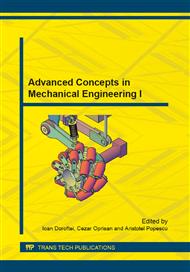p.553
p.557
p.563
p.569
p.575
p.581
p.587
p.593
p.599
Low Cost Device for Experimental Tests of Electrorheological Fluids
Abstract:
Electrorheological fluids (ERFs) can change their shear stress and shear rate as a function of the electric field intensity thus, such fluids acts as Newtonian fluids, if no electric field is applied and, become non Newtonian fluids if the presence of an electric field. In the last years, a growth interest is manifested for incorporating smart fluids into structures, as clutches or dumpers. The ERFs shear rate and shear stress must be determined at the moment of designing such mechanical structures. The fluids viscosity is studied by aid of commercially available viscosimeters or rheometers, these do not have the possibility to apply an electric field to the studied fluids. The ER fluids must be studied into specific electric field intensity. This paper presents: a low cost experimental rheometer and experimental results obtained form a study of several commercially available ERFs.
Info:
Periodical:
Pages:
575-580
Citation:
Online since:
October 2014
Authors:
Keywords:
Price:
Сopyright:
© 2014 Trans Tech Publications Ltd. All Rights Reserved
Share:
Citation:


